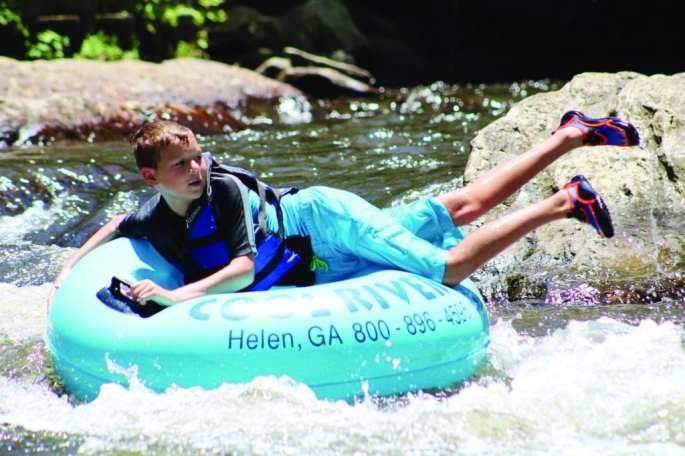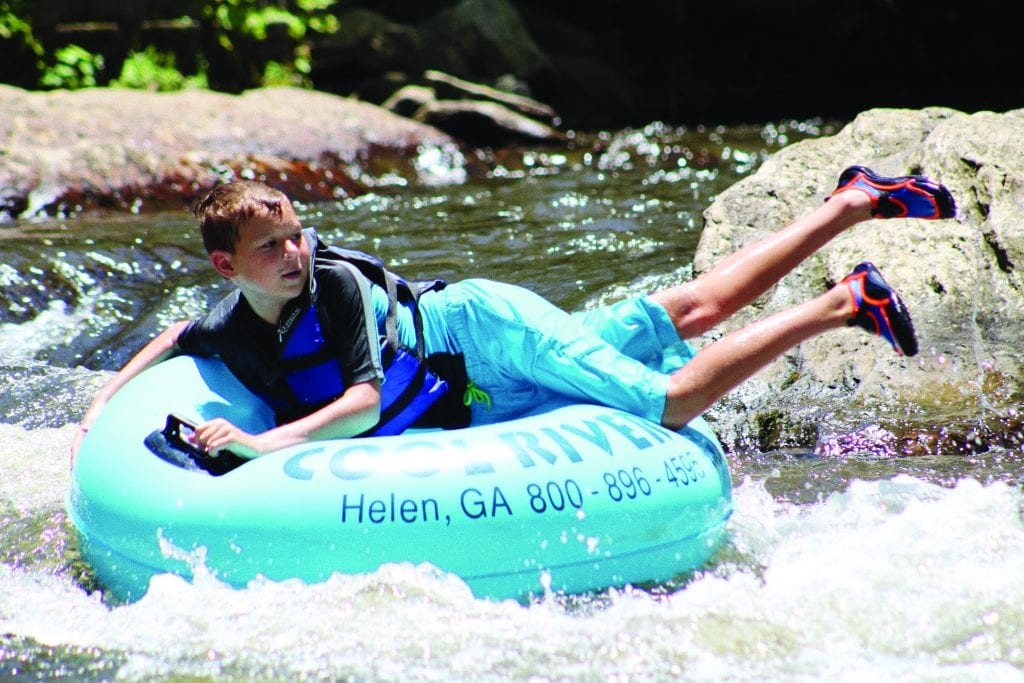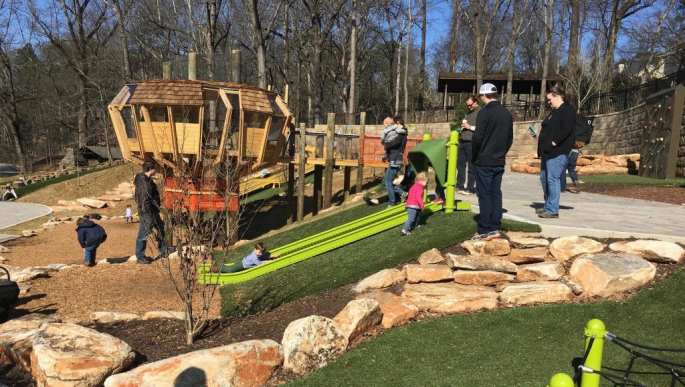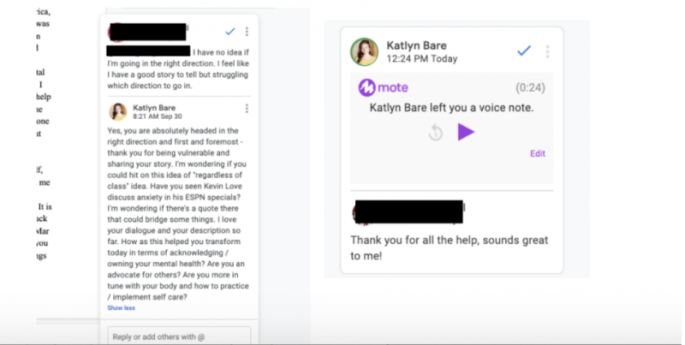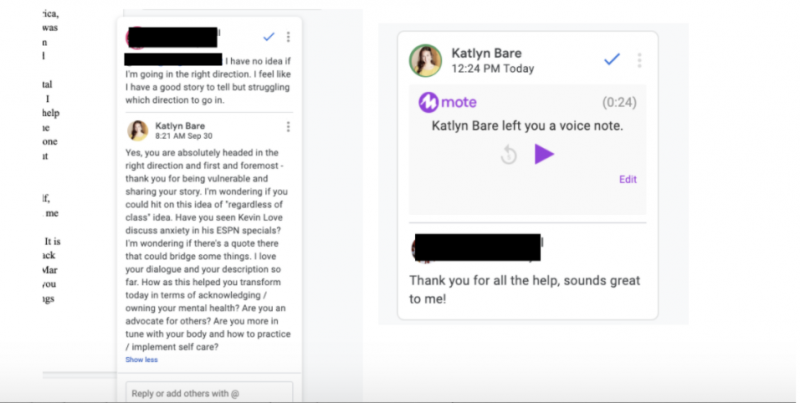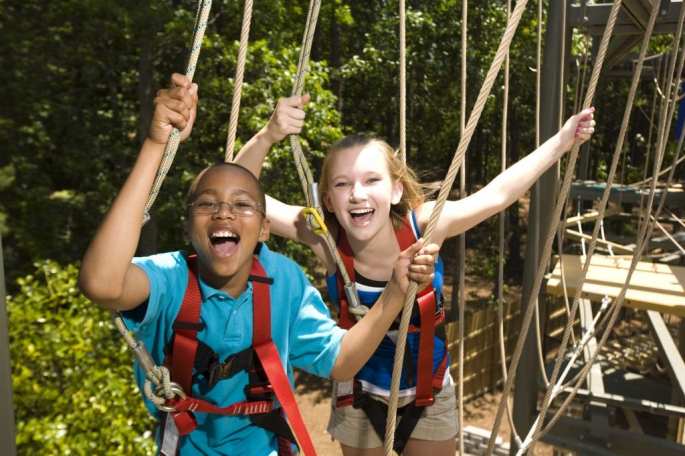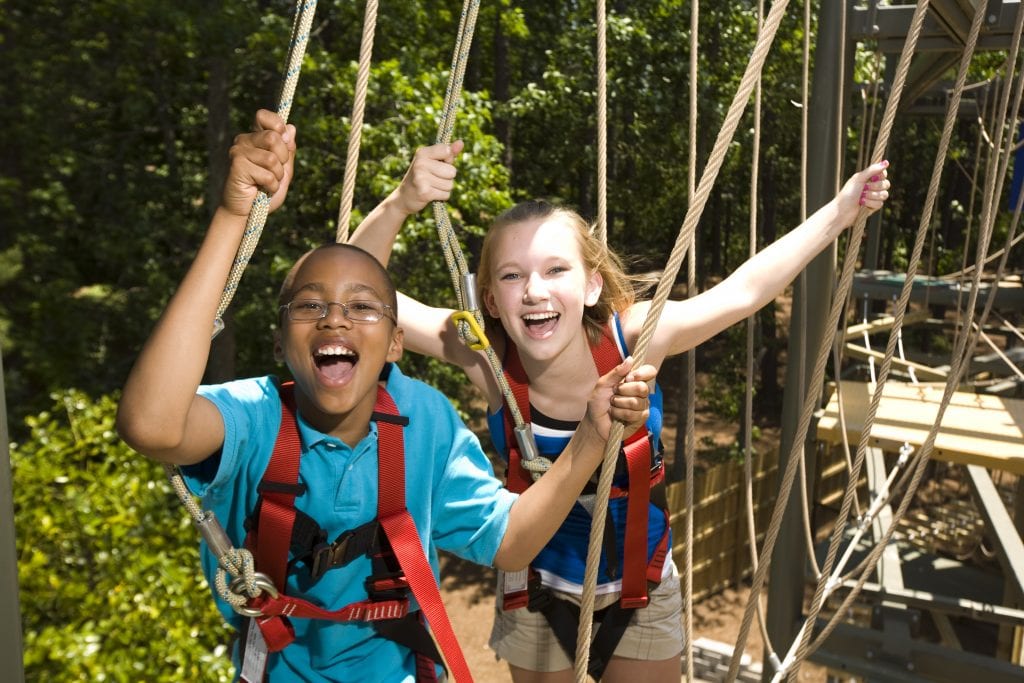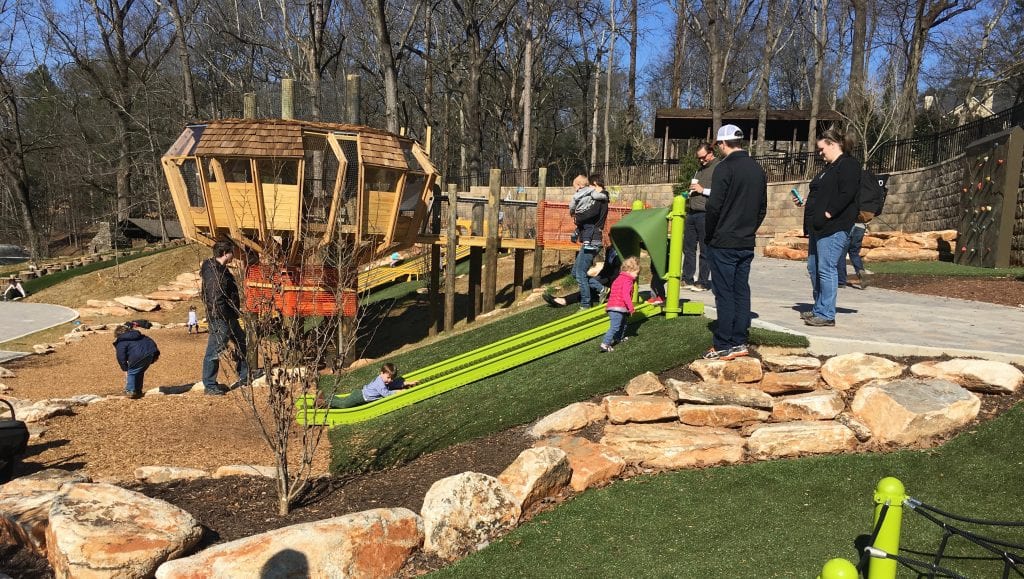
Chastain Park
Our top parks and playgrounds in metro Atlanta include everything from innovative play structures, skate parks and sand boxes to trails for hiking, trees for climbing and creeks for splashing. We have rounded up so many parks that no matter where you live, you can find some outdoor family fun.
Find a playground to explore:
Downtown & Westside Playgrounds in Metro Atlanta
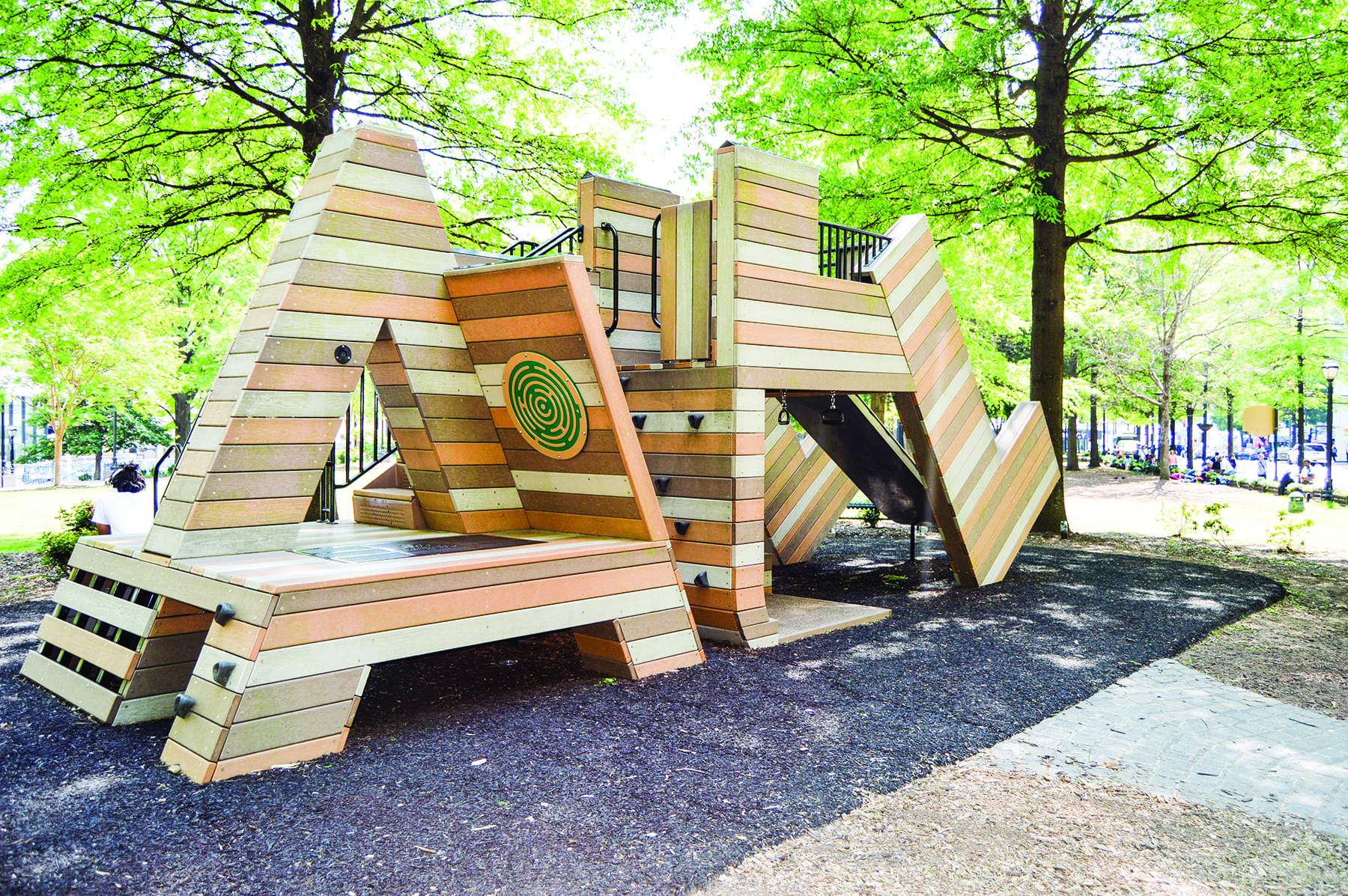
Woodruff Park
Anyone with “ATL” pride will love this playground shaped like the famous letters. An international design competition sparked the building of this playground by a Canadian designer. Kids can climb all over the walls, monkey bars, slides or play with the springs and spinners. Street parking is limited so we recommend visiting by public transportation.
This playground sits in the heart of downtown and is for all ages and all abilities. The surface is made of soft rubber and the play area includes many multi-sensory play elements as well as a great climbing structure. Much of this kid-friendly oasis sits beneath an awning that allows cover from the sun.
Two great play areas are hidden under the large trees in Piedmont Park to provide natural shade. The Mayor’s Grove Playground is designed for kids with and without special needs with fun play structures. The Noguchi Playscape is next to the park’s 12th Street gate and looks more like a modern sculpture garden than a playground. A giant, winding slide and other features help familiarize children with shapes, colors and textures.
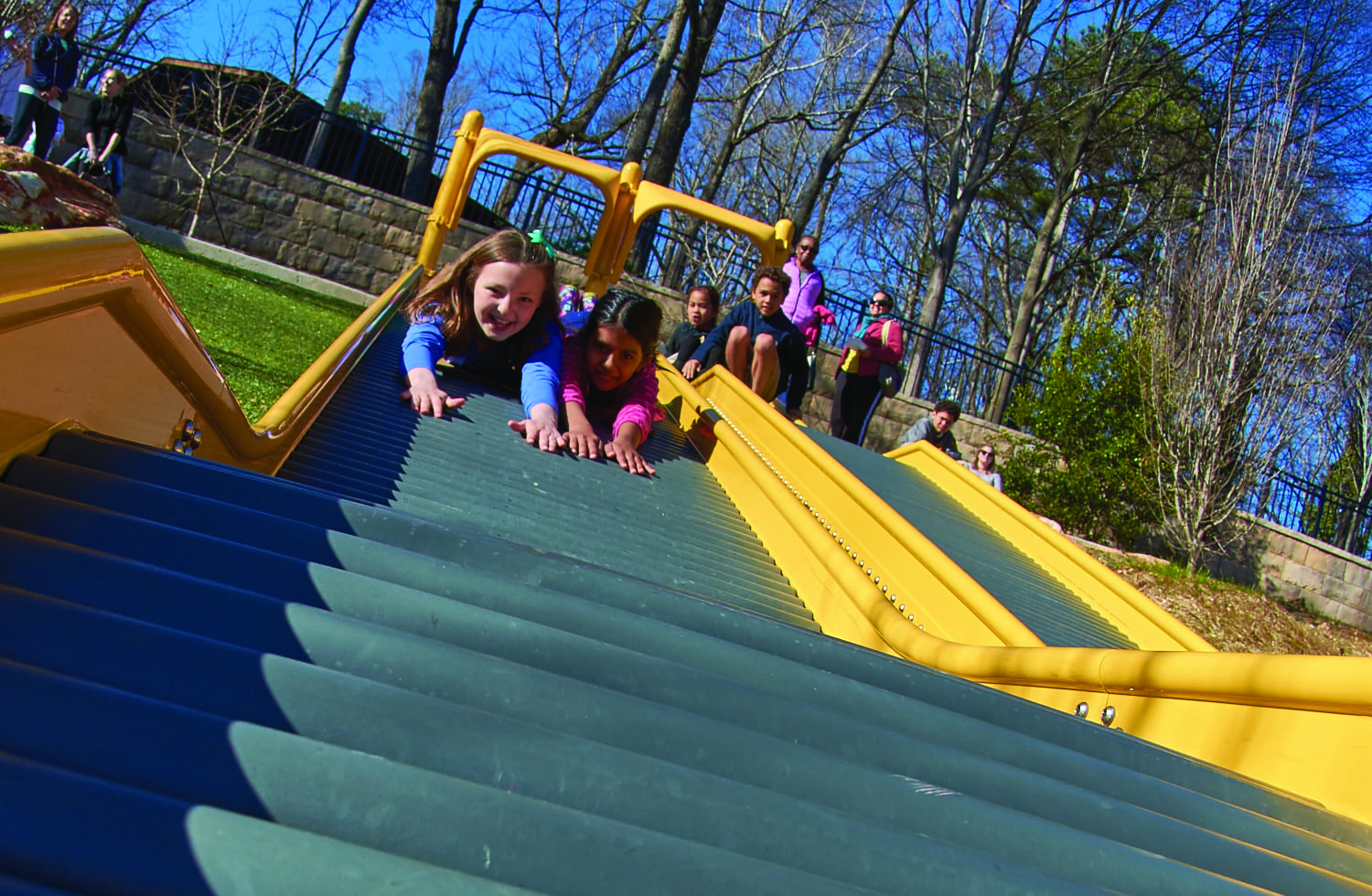
Chastain Park Playground
Kids can climb and explore in the treehouse, slide down one of the three large roller slides or play on the natural playscapes. Three giant “oodle” disc swings allow two children to recline and swing together and there is a spider web for climbing. The music area includes drums and chimes.
The Atlantic Station Playground is a great stop for getting the wiggles out if you’re shopping or sightseeing in town. Other than two traditional slides, every piece of equipment is more modern and inventive than typical playground options. Even the benches are unique looking.
This urban oasis boasts gorgeous scenery with a winding creek, sprawling green spaces, bridges and trees with a trail leading up to an inviting playground nestled in the middle of the park.
Set below street level in Ansley Park, this park provides a safe area for kids to run around or utilize the playground. While significantly smaller than its neighbor, Piedmont Park, Winn Park usually a lot less crowded.
True to its name, this small park in Buckhead offers lots of shade. Kids love the cool playground equipment; parents love the rubber ground under the playground. Everyone loves the big, colorful mural.
This is a great little park in Buckhead with abundant scenery, a creek, a bridge and ample walking trails. Visit the nice-sized playground so kids can get their wiggles out while parents can enjoy the nearby shade.
Little Nancy Creek park in north Buckhead may indeed be little but its playground is big (and looks like a treehouse). There is also a walking trail, community garden and the creek itself.
Eastside Playgrounds in Metro Atlanta
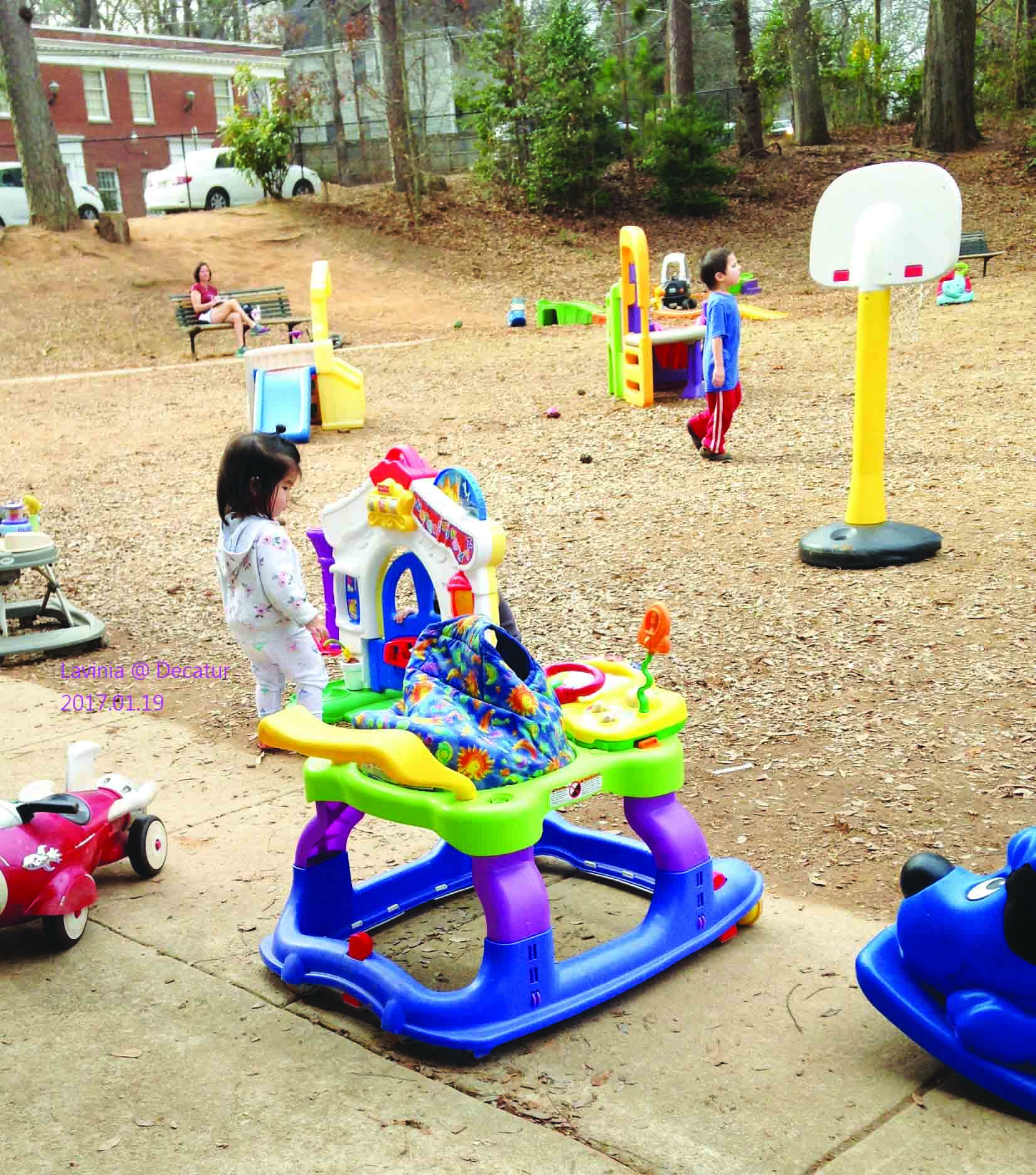
Decatur Toy Park
Scooters, tricycles, small slides, push cars galore – this park is filled with toys families decided to donate, and is a great place for toddlers to play. If your older kids want to slide, swing or hang from monkey bars, they have that too.
Two separate playgrounds sit right across from each other. The larger is best suited for older kids, ages 5-12. A giant pirate ship-shaped play structure with a three-level tree house provides lots of playing, climbing and sliding opportunities. The tree house is for children who aren’t afraid of heights.
Families love this green space, located near shops and restaurants in Kirkwood. Kids especially enjoy the playground with a tire swing, see-saws and even a rock wall. Parents especially enjoy the mature trees nearby that provide shade in the hotter months.
Another Kirkwood hot spot, Coan Park offers visitors tennis courts, a baseball field and a pretty cool, accessible playground. But beyond that parents appreciate the exercise equipment strategically placed close to the playground. Don’t miss the musical instruments that kids can play near the rotunda pavilion.
A neighborhood favorite—this one has plenty of areas for kids, dogs and adults to run around, plus a great playground and even some interesting stone sculptures. You can’t miss the magnificent oak tree, perfect for climbing, swinging or just sitting in the shade.
Atlanta residents flock to this “energy cost-neutral” park that was once a landfill. A canopy of solar panels generates enough energy to power ten homes and of course provides shade for visitors. Add to that a playground and a splash pad and it’s no wonder this park is so popular.
When people say “Grant Park” they often mean the neighborhood but there is also the actual park which is home to Zoo Atlanta. Find tennis and basketball courts, a baseball field, a swimming pool, a playground, and walking trails on 131 acres of wooded area. Go for a stroll down the wide paths of Grant Park while the kids run free.
Kids go crazy over this playground right next to a runway (with a fence of course). They can watch planes take off while swinging, scaling the monkey bars or sliding down the curvy slide. They can also play in the pretend cockpit or better yet, host an airplane-themed birthday party while planes fly above.
For a true adventure with nature, check out Lullwater Preserve on Emory University’s campus in Decatur. This peaceful park is amazingly fun for kids. They love to explore the old mill, waterfalls and a 210-foot suspension bridge.
A great, safe neighborhood park in Decatur, McKoy has something for everyone—a colorful playground, exercise equipment and even a skate park.

Murphey Candler Park
The park began making improvements in October 2020, and while the project is not set to be completed until fall of 2021, the new playground should be completed this month. These improvements include a castle-like playground, swings, springers and a tree climber. While there, spot the cute storm water access points painted to look like animals! With different playgrounds for different age groups, all kids can have a blast at Murphey Candler park, located in Brookhaven. Families also enjoy the hiking trails, lake and picnic pavilion.
This beautiful city park with access to the BeltLine has a super cool playground. It’s packed with climbing elements, slides, swings, rock walls and even a trampoline kids can jump on. The spider-like ropes course and large swings shaped like bowls are two favorites. Don’t miss the nearby splash pad on hot days.
This park is mostly popular with the four-legged set and their owners but kids (who aren’t dog shy) will have fun here too. It has plenty of room to run around, plus a playground and trails.
Freedom is a linear park at the intersection of North Ave. and Freedom parkway without a playground, mostly frequented by joggers and people walking their dogs. Still, families enjoy strolling along the trails, seeing the unique art sculptures throughout the park and searching for tiny doors.
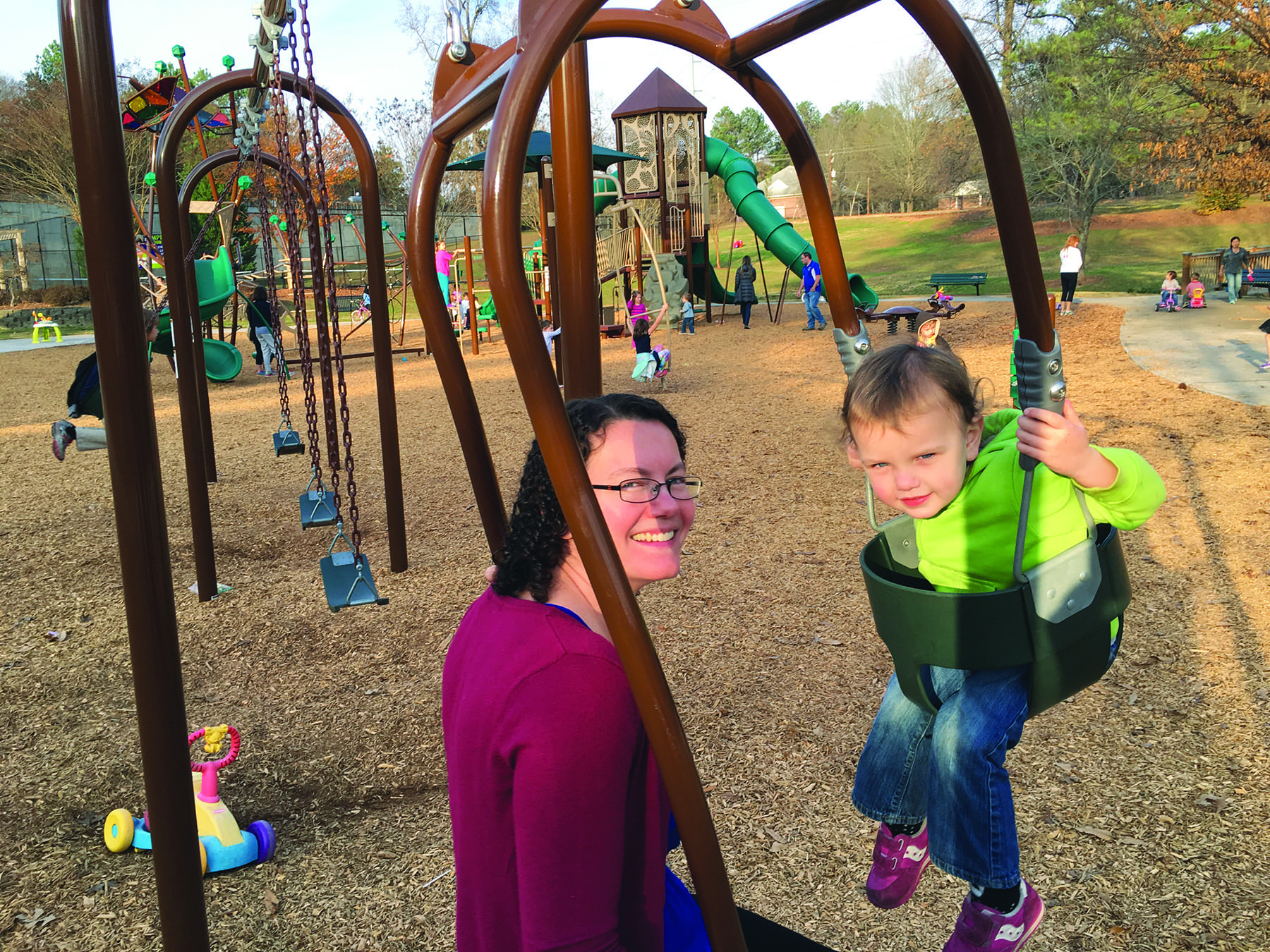
Ashford Park
The recently renovated park in Brookhaven includes two new play structures, tall slides, tons of swings, a seesaw, a huge sand box and toy park area. Watching the MARTA trains speed by is an added bonus for kids.
This eight-acre Decatur gem offers a fun playground, baseball fields and impressive basketball courts.
For summertime fun, Best Friend Park in Norcross has a great pool with a waterslide and splash pad (for a fee) and also has a playground with swings, basketball courts, tennis courts and a walking trail.
A hidden gem in Tucker with both paved and walking trails with a beautiful lake backdrop. It has a couple of playgrounds, one that is shaded by trees and conveniently located by a covered picnic pavilion.
Sure, Stone Mountain is a huge Atlanta attraction with tons of activities that cost money, but it’s also a beautiful, fun park. If you plan to visit more than three times a year, it’s worth it to buy the parking pass. Once you pay to park, you can enjoy a lot of things Stone Mountain has to offer without getting out your wallet—hiking, biking, walking, grilling and playing on the playground.
Southside Playgrounds in Metro Atlanta
It has two sets of playing equipment, one for younger and one for older kids, although children usually run back and forth between both sets. Families who like to exercise together enjoy the beautifully shaded one mile trail.
A favorite for Peachtree City families, this lakeside park has a wonderful enclosed play space called the All Children’s Playground that sits on artificial turf. Kids also love to feed the geese that come up onto the banks of the lake and of course, families love to picnic there underneath all the shady trees.
A small but beautiful park in Peachtree City, Luther Glass has a basic playground, walking and biking paths and ponds for fishing. The park actually has three separate ponds which is why locals often refer to it as “three ponds park.”
Set on Lake Peachtree, this is a beautiful park for catching the sunrise or sunset. Families enjoy walking along the path by the lake or using the playground.
Another gorgeous lakeside park in Peachtree City with picnic pavilions and a playground right by the water. People flock here for water activities like kayaking, paddle boarding and fishing.
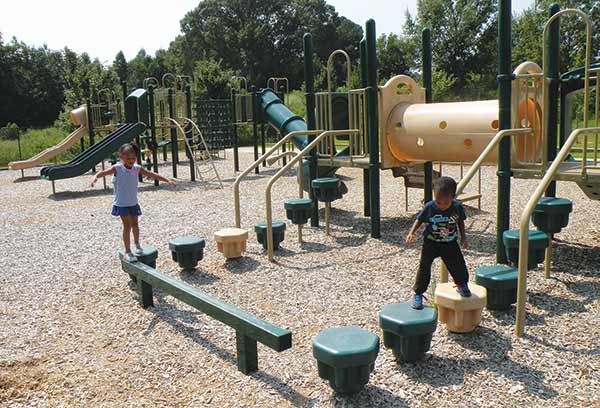
Ben Hill Park
Ben Hill Park is tucked within the Ben Hill neighborhood in Southwest Atlanta. It has something for every age. Older children can play basketball while younger ones can spend quality time with their parents together on the swings.
Northside Playgrounds in Metro Atlanta
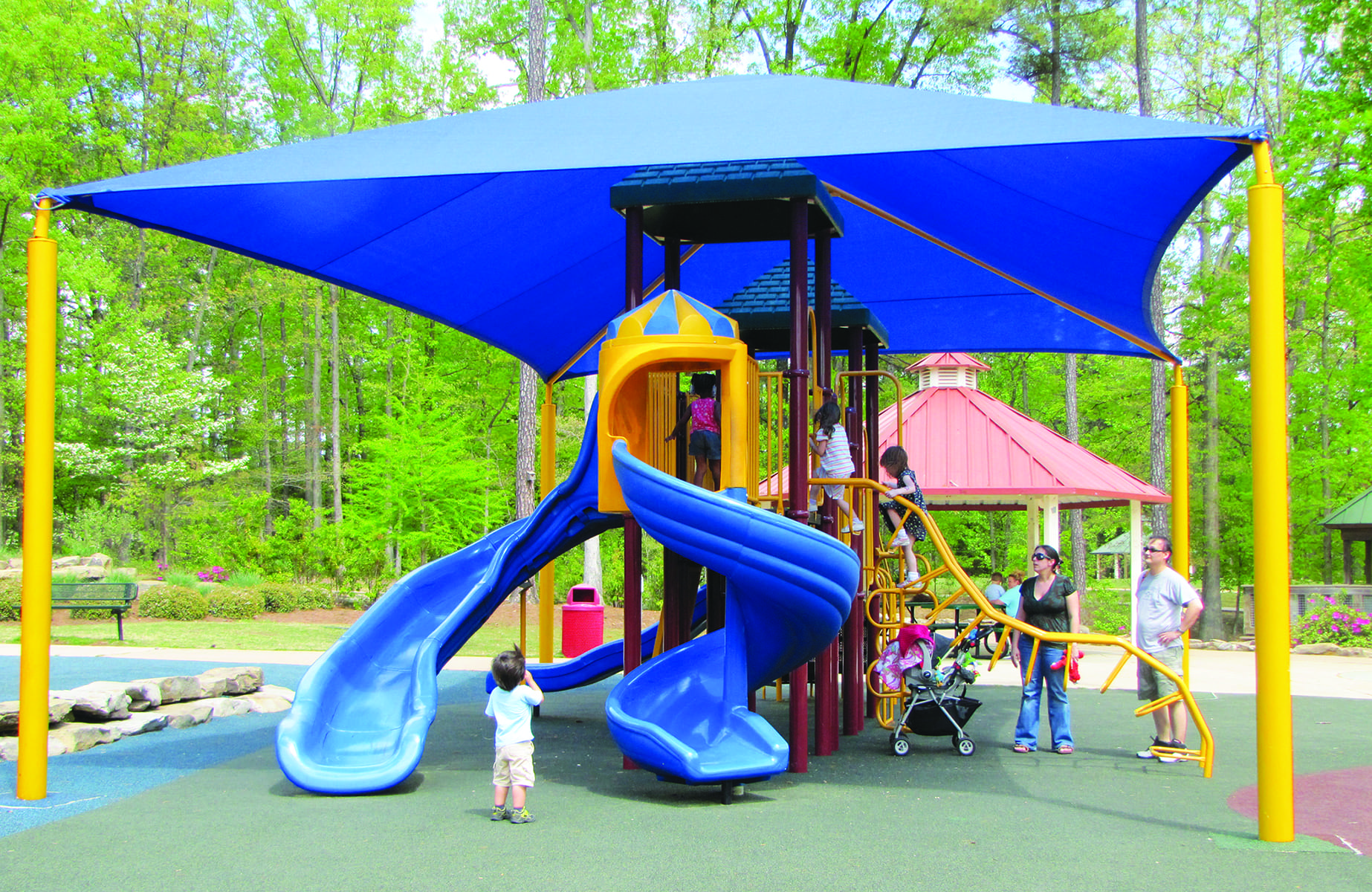
Brook Run Park
The Children’s Adventure Garden at this Dunwoody park has clusters of bright play structures with shades above to hide from the sun. The play structures are separated for toddlers and older kids. There is so much to get into: slides and swings of varying sizes, several sets of monkey bars, a multicolored tunnel, and a “log roll” for balancing. The cushioned rubber matting will help protect from scrapes and bruises.
This huge park in Duluth has an impressive, castle-like playground with big, twisty slides and a web tire swing among other things. Parents with toddlers love the nearby soft-ground play area and all parents love the gazebo with picnic tables. Bunten Road Park also has scenic walking trails.
Right next to city hall in Duluth, this park may be small, but it makes up for it with its train-themed playground equipment. It is easy for parents to keep an eye on kids because of the park’s size. There is also a grassy area for running around.
This park in Dunwoody may be on the small side, but its playground offers the trifecta for families—shaded, fenced and soft surface.
Another Dunwoody favorite, Winwood Hollow Park has a fantastic, shady playground for all ages. It includes a tiny roller coaster track perfect for matchbox cars, rope climbing structures, a leaning climbing wall ladder, monkey bars, three different slides, riding elements such as spinning stools and airplanes, and regular, baby and disk swings. There are also chimes and bongos for kids to play.
A top-notch playground with equipment for all ages is the highlight of this park. It is spacious and has lots of slides, monkey bars and plenty of swings. Kids also like to splash in the creek, walk the trails or play in the spacious, grassy areas.
It may be home to the Dream Dog Park, one of the best dog parks in the country, but Newtown Park in Johns Creek has pretty dreamy offerings for kids too. The two playgrounds have lots of fun, innovative equipment that will keep kids busy. It also has a beautiful, shaded trail all around the park.
Kids are never bored at Bay Creek Park in Loganville. They have walking trails, basketball courts, baseball fields and even a skate park. Families absolutely love the accessible playgrounds which feature rubberized surfaces, supportive swings, wide slides and a wheelchair-accessible sandbox
Most people visit this multi-use park in Marietta for its sports facilities—baseball, football, soccer and tennis. But it has a nice little playground as well as many covered pavilions that can be rented for parties.
Families can spend a whole afternoon at Heritage Park in McDonough, seeing The Veteran’s Wall of Honor (engraved with battle scenes), The Veteran’s Museum and lots of historical structures like Henry County’s first library. Kids especially love the 1972 UH1 Huey helicopter as well as the playground called “Kidsville.”
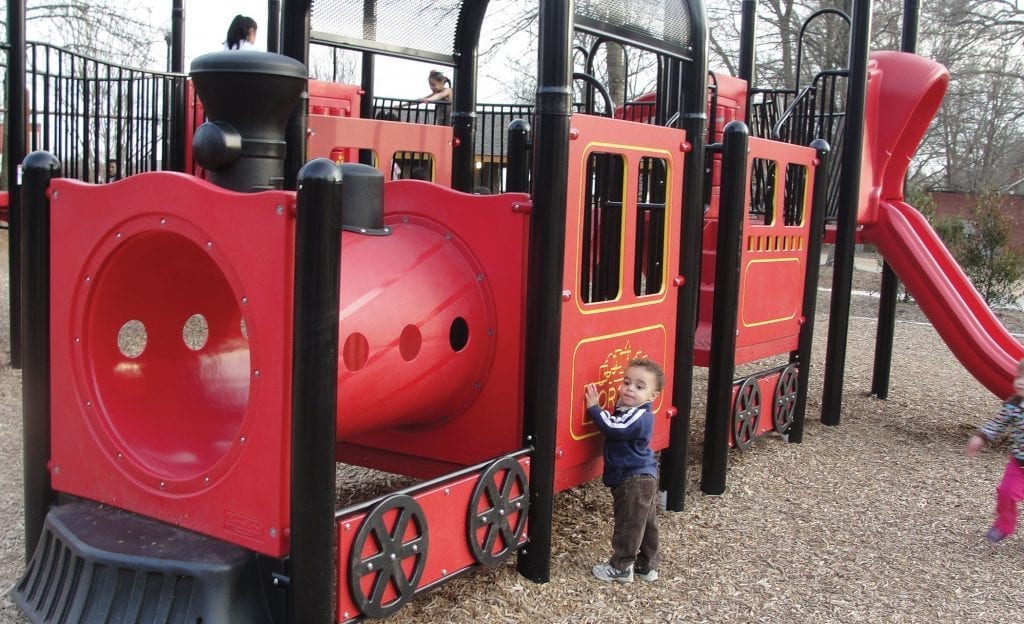
Thrasher Park Playground
If your kids love trains, this playground in downtown Norcross is the right pick. Climb all over the bright, red train play structure and watch real trains chug by on the tracks. Spinning elements and a net climbing structure add to the fun.
Roswell residents mostly go to this park for its recreation center and baseball fields. But it has a big playground area with unusually tall slides and plenty of swings.
RAP (as locals call it) truly has it all—awesome playgrounds with separate areas for older and younger kids, picnic pavilions, baseball fields, walking trails and a pool. The best part is that the whole park is filled and surrounded by trees, offering lots of shades in the hotter months.
Named after Leita Thompson, one of the first female banking executives who bought and donated the land for this pretty and serene park in Roswell. While it doesn’t have playground equipment, it does have beautiful trails which are fun for walking or for going on a nature scavenger hunt.
The old playground at this recreation center was replaced with a new adaptive playground for ages 5-12 and features slides, swings and music-making structures. Updates also include new shade structures, a connective side walk and a new pavilion.
For a roomy playground that promises plenty of fun for all ages, Oakdale Park in Smyrna is a sure bet. The enclosed playground with a soft rubber surface features two different sections: a play zone for the younger set, and another that offers more challenging action – including a rock-climbing component.
Folks in Dacula are lucky to live so close to this amazing park. The shaded playground not only has a soft surface and cool equipment but it also boasts a sand area. And speaking of sand, this park also has sand volleyball courts. The skate park is a popular spot.
Another Dacula favorite, this 200-acre park is a blast for families. It also has sand volleyball courts. The playground (which is on artificial grass) has plenty of swings and twisty slides and nearby shallow canals for kids to splash in during the hotter seasons. Children especially love the dinosaur fossils that they can climb on at Rabbit Hill Park.
This 25-acre neighborhood park in Chamblee is on the smaller side but it does have decent sized grassy areas, shaded walking trails, picnic areas and a pretty creek running through it. Parents visit it for the semi-enclosed playground with its soft surface.
This Smyrna park has lots of options for sports like softball and tennis. But it also has two playgrounds with cool equipment (rope-climbing structures, for instance), picnic pavilions and a fitness trail.
It’s shade all day at this gorgeous Alpharetta park filled with baseball fields, soccer fields and walking trails. The two wooden playgrounds are truly unique with a little play creek that runs through one of them.
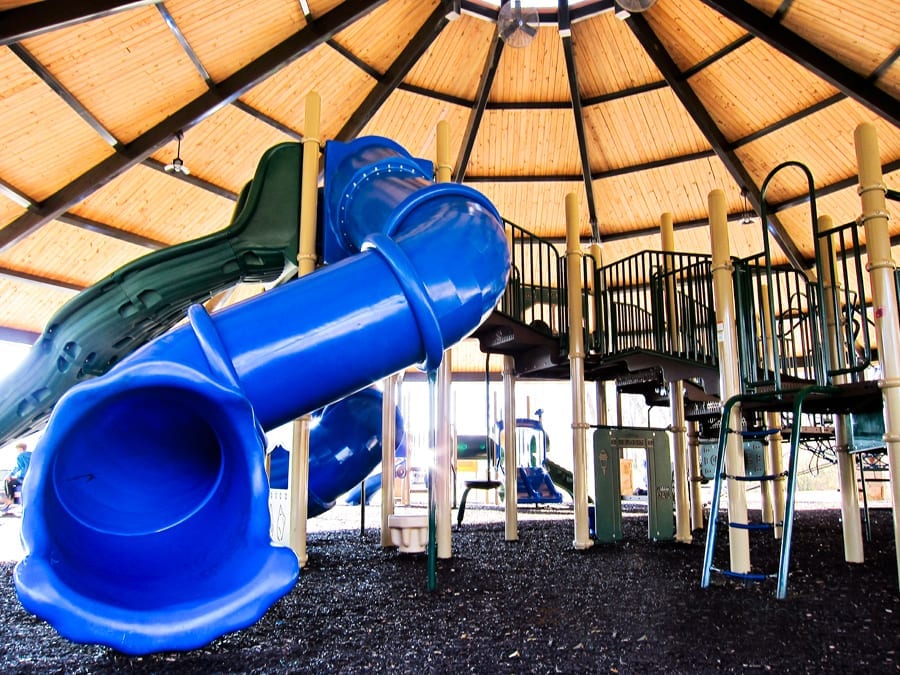
Gary Pirkle Playground
This playground in Sugar Hill wins for hot summer days or the unexpected rainstorm because it is completely covered by a large pavilion to keep the weather out. No more having to leave the playground because of a storm.
The 91-acre Alexander Park in Lawrenceville is filled with plenty of green space and undisturbed landscaping. The bright new playground off the Scenic Highway entrance includes a two-story playscape with tube slides, a cargo net and a climbing structure. The playground is also shaded! There’s a smaller playground for toddlers. The park has three trails – more than three miles in all – for walking, jogging and biking. There’s also an 18-hole disc golf course that gets plenty of action, as well as two ponds (each with its own fishing dock), a horseshoe pit and an outdoor classroom.
The vast playground in Lawrenceville is separated into two distinct areas. One structure is for smaller children, with small steps leading up for easy access to the slides, musical features and more. The other structure, for the older set, is more adventurous; big kids can enjoy everything from a daring, high boulder walk to a complex monkey bars section.
Because the playground—more than 3,000 square feet—is tucked deep inside this Smyrna park, traffic noise is filtered out. This is a unique space where having fun with your children is guaranteed. One area is designated for ages 2-5, and another for ages 5-12. Play equipment was selected partly to blend into the natural landscape.
Young and old visitors will enjoy seeing the colorful, fiberglass cow sculptures throughout the pavilion. The playscape is in a natural setting with lots of shading. Built for both school-age children and toddlers, kids can climb on the bridge, slides or climbing walls. The playground features a castle, log cabin and rocket. The sand activity area is a fun place to dig and play.
This playground at this park in Cumming is similar to the soft play areas at malls, but in the middle of the woods. When arriving, take a short walk through the wooded area and the playground will appear. Three “pods” are connected by walking paths and kids are challenged to let their imaginations take over. Play on giant acorns, logs, big bugs, super-sized mushrooms, a mama bear and two cubs and a bigger log with a climbing net attached.
The park features two large playscapes: one for both older and younger kids and one just for younger kids. Children can enjoy swings, climbers, bridges and other playthings. “New patterns of play” are encouraged in a contemporary play system that includes circuits, walls, rings and more. A recent remodel has made the playground inclusive for all children, and features include slides, swings, ADA ramps, sensory stations, play structures, a ropes tower, an eight person wheelchair sway and more.
At this Johns Creek park, you’ll find two structures for play—one for children ages 2-5 and another for older kids. On the “Ten Spin” Merry-Go-Round kids can sit or stand and spin around. The generational swing allows a younger kid and an older kid or parent to swing together at opposite ends. The Avalanche slide is another cool feature that lets kids use their upper body strength to climb up and then slide down.
This large, mostly shaded park in Alpharetta with a walking trail and baseball fields has something for everyone. The highlight is “Wacky World,” a wooden kingdom with towers, bridges and passages, with sections for older and younger kids. Children can navigate the rope bridge, climb to a tower lookout post, or take a spin in the tire swing. The yellow playground offers equipment for younger kids, and the covered purple playground has climbing structures and swings for big kids.

Morgan Falls Overlook Park
This park is a Sandy Springs treasure, with plenty of green space overlooking the Chattahoochee river. Its modern playground with unusual climbing elements has two play structures that serve both younger and older kids with places to climb, slide and explore. But the spot where they all come together is the spider web, a tall rope structure that provides a climbing challenge. Shades give cover from the sun and the AstroTurf helps with falls.
Kids will essentially enter a sculpture garden they can play on at this Sandy Springs park. Climb, swing and jump from real art structures including the yellow, spider-like structure, the mosaic climbing wall, the large, red swings and the many other jungle gym climbing areas.
This natural-themed playscape includes log-like staircases, swings, a cozy dome, a we-saw and a crawl tunnel. This smaller playground is perfect for preschool and elementary aged kiddos.
Set on the white, sandy beach of Lake Acworth, this park has a nature-themed playground that fits right in with the surroundings. Younger kids can swing or bounce on different play elements and older kids will love the large jungle gym structure or the “spider net” climbing area. All kids will love the giant, towering climbing areas and slides.
The newly-renovated playground right by Sweet Apple Elementary in Roswell offers fun for young and older kids who want to climb, slide, swing and zip line. Highlights include the generational swing and the rope-climbing spider web. The mostly shaded playground with a picnic pavilion features colorful slides as well as a small children’s play area with a large sandbox. The playground is open to the community outside of school hours.
This Smyrna park has several play structures for all ages, most with giant umbrellas for shade. The colorful playscapes allow for climbing, swinging or sliding. There are shorter climbing walls for going up and over, a telescope, tall boulders to climb and a spider web structure. The toddler play area has smaller swings and slides.
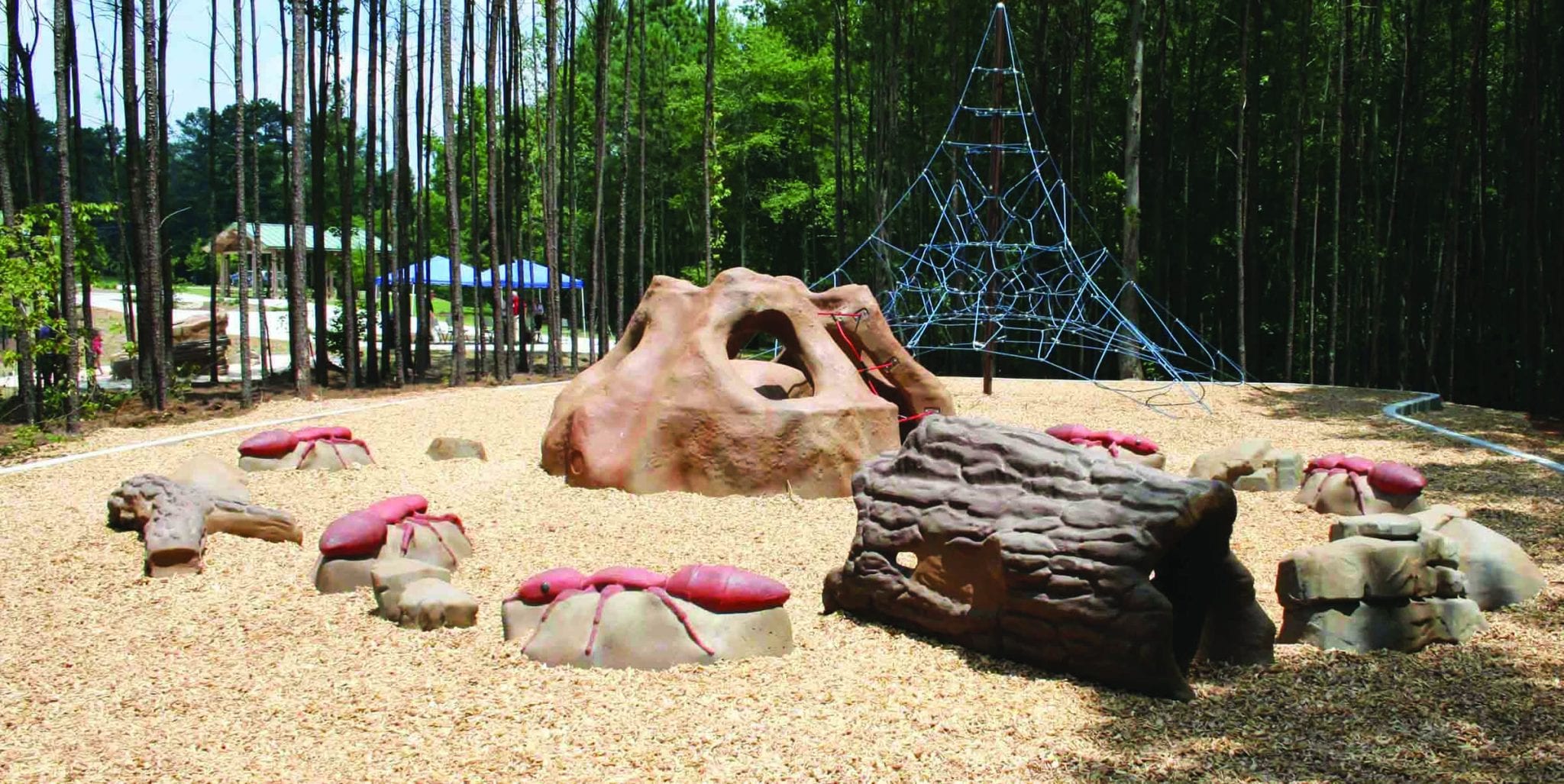
Caney Creek Preserve Playground
Kids love to come to this Cumming park for the dinosaur dig area. Adventurous kids like the spider web climbing net too. Children can play around the nature trails or climb aboard the logs or boulder play structures.
This gorgeous park that sits on the banks of the Chattahoochee River in Roswell is the setting for many concerts and events. Families flock to this park, mostly for its three awesome playgrounds. Two of them are more for older kids with tall slides and one is for the younger set. In the summertime the main attraction is the splash-n-play sprayground.
A canopy of trees provides natural shade at this hidden Roswell park. Kids absolutely love the playground which several shapes and sizes of slides, swings and plenty of climbing structures. Parents love the covered pavilion with tables right by the playground.
The Chattahoochee River is the backdrop for this Roswell park that is a hot spot for kayakers and paddle boarders. A nice little playground gives the kids lots of exercise (with pint-sized rock climbing walls) while parents enjoy the view.
With free admission for most activities, families can enjoy nature and play at Dunwoody Nature Center. The play structures on the playground will delight your children. There is one for toddlers and one for older kids. (The slides are super-high!) They also have freestanding structures including a cube of ropes, a large rope swing and a standing seesaw. Kids also like to check out the treehouse which offers a great view of some of the trails, as well as Wildcat Creek.
Designed for ages 5-12, this new playground features slides, swings, one accessible swing and an IKO ball climber. The park also boasts a covered bridge, picnic tables along Settingdown Creek and the Cumming Garden Club’s Memorial Garden.
– Elsa Simcik contributed to this article.
Check out other newly updated playgrounds here.
The post 75+ Best Atlanta Playgrounds and Parks for Families appeared first on Atlanta Parent.
Source


9(MDAxOTAwOTE4MDEyMTkxMDAzNjczZDljZA004))
